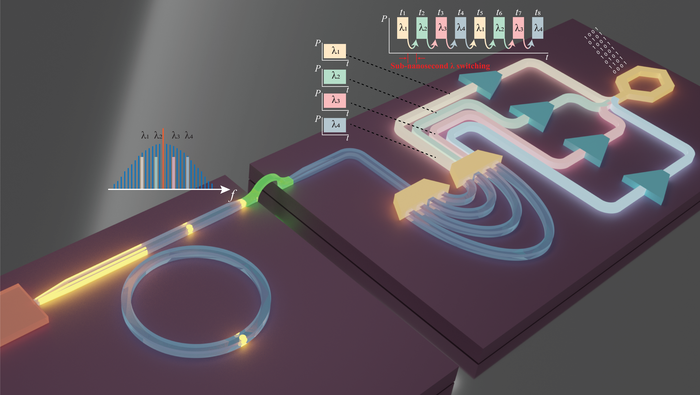Hyper-scale cloud providers such as Microsoft offer services powered by voluminous data centers that use hundreds of thousands of servers, whose performance relies on the network quality between them.
 An illustration of photonic integrated platform that enables the ultrafast optical circuit switching for datacenters. Image Credit: Aqeel Ahmed/EPFL.
An illustration of photonic integrated platform that enables the ultrafast optical circuit switching for datacenters. Image Credit: Aqeel Ahmed/EPFL.
Available datacenter networks include multiple layers of electrical packet switches that are interconnected via optical fibers. Electrical-to-optical conversions are demanded by these systems, which raises the cost and power overhead.
To add to the challenges, increasing data rates due to applications like AI and data analytics could concur with the slowdown of Moore’s law, which would make it challenging to measure the current network architectures that depend on electrical chips.
Optical circuit switches (OCS) are becoming an attractive option for addressing the bandwidth and scaling issues at datacenters. A specific promising OCS design is the wavelength switching where distinct servers are connected using several colors (wavelength) of light, resulting in flatter network architecture and restricting the requirement for the electrical switches and optical transceivers.
A switching element is used to change the wavelength of light and routine signals to destination servers — for example, a glass prism through which several wavelengths can be separated by dispersion.
OCS technologies are available in the market but they are extremely slow, implying that they cannot handle bursty datacenter applications while making proper use of network resources to lower the overheads and enhance power consumption.
The study was published in the journal Nature Communications.
The research team was led by Professor Tobias J. Kippenberg at EPFL and by Dr. Hitesh Ballani at Microsoft Research Cambridge. The study could demonstrate the ultrafast OCS for datacenters by using chip-based optics. The research team has been working together since 2018 as a part of the Microsoft Swiss Joint Research Center.
The optical micro combs, as presented in the architecture, serve as a multiwavelength source offering coherent carriers. Optical amplifiers and arrayed waveguide gratings based on semiconductor materials achieve combining or separation of the different colors of light through the switching process.
As proposed by Kippenberg’s group, the optical microcombs offer hundreds of equidistantly spaced carriers that are adaptable for several applications. The micro comb is produced through nonlinear frequency conversion by employing a chip-scale silicon nitride microresonator, offering distinct advantages in power and size when compared to the traditional multiwavelength sources.
The photonic damascene process is used to fabricate silicon nitride microresonators. This is a process in which the CMOS-compatible technique features ultra-low propagation loss, which is extremely crucial when seeking to generate power-efficient microcomb sources.
The optical amplifiers based on chip-scale indium phosphide are fabricated using commercial foundries, which perform the switching operation between different colors of light at sub-nanoscale timescales. This ultra-fast switching between several microcomb carriers is key for achieving the desired performance of modern and future data center applications.
A proof-of-principle, system-level study indicated that the data transmission with packet-by-packet switching can be realized and has the capability to fulfill the requirements of datacenter applications. Ultimately, the researchers present a distinct architecture that uses a central comb to enhance the power efficiency and lower the complexity.
Soliton microcombs have been used in many key system-level applications such as LiDAR, long-haul data transmission, and optical coherence tomography since their discovery back in 2014. The potential use of microcombs in datacenters to meet future bandwidth requirements and reduce power consumption further consolidate the importance of this platform for scientific and technological applications.
Tobias J. Kippenberg, Researcher and Professor, Ecole Polytechnique Fédérale De Lausanne
The silicon nitride samples were fabricated and grown in the Center of MicroNanoTechnology (CMi) at EPFL.
Funding
This study was financially supported by the Microsoft Swiss Joint Research Center (Joint research ICES), Air Force Office of Scientific Research (AFOSR), Swiss National Science Foundation (SNF) and EU H2020.
Journal Reference:
Raja, A. S., et al. (2021) Ultrafast optical circuit switching for data centers using integrated soliton microcombs. Nature Communications. doi.org/10.1038/s41467-021-25841-8.